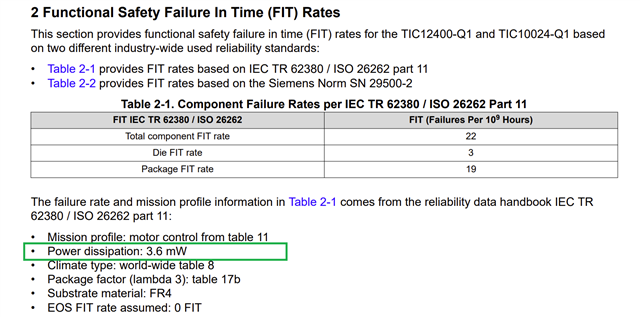Hi, Support Team
Could share TIC12400-Q1 about power dissipation document?
we also find the FIT document, show Power dissipation: 3.6 mW
how to calculator?

if any, Please advise me.
Thanks,
Best regards,
Lawrence
This thread has been locked.
If you have a related question, please click the "Ask a related question" button in the top right corner. The newly created question will be automatically linked to this question.
Hi, Support Team
Could share TIC12400-Q1 about power dissipation document?
we also find the FIT document, show Power dissipation: 3.6 mW
how to calculator?

if any, Please advise me.
Thanks,
Best regards,
Lawrence
Hi Lawrence,
Are you specifically asking about power dissipation used in the mission profile for the FIT rate calculations?
Or are you asking how to calculate the power dissipation of the TIC12400-Q1 for your application? If so, are you planning on using Continuous Mode or Polling Mode for your wetting current?
Regards,
Jonathan
Hi, Jonathan
yes. we asking about power dissipation for FIT rate calculations
if any, Please advise me.
Thanks,
Best regards,
Lawrence
Hi Lawrence,
We do not have a calculator tool for power dissipation to provide. The datasheet contains the current levels for different portions and modes of the devcie which could be used to calculate the power dissipation for your specific application. The Wetting current flowing through the INx pins will be the biggest unknown and will differ between Continuous Mode and Polling Mode configurations.
For Continuous Mode, the wetting current will not be disabled between polling cycles, so calculating the current and power is straightforward for and open and closed switch or a known resistive load in the INx pin.
For Polling Mode, this calculation is more difficult because the wetting current is only enabled for a portion of the polling cycle and then disabled. There is a polling mode current calculation tool built into the TIC12400EVM GUI that is free to download and use without purchasing or connecting an EVM. You can download the software from this (link).
Once you know your current consumption for your application, you can calculate the power dissipation based on the supply voltage you are using.
The power used for the FIT rate calculations was based on an assumed typical use case.
The publicly available tools for FIT calculations can be found on ti.com (link). The tools used with the FIT rate calculations in the published document are not public tools. However, if there is a specific power level you need calculated, I can try to work with you to create a new calculation.
Regards,
Jonathan